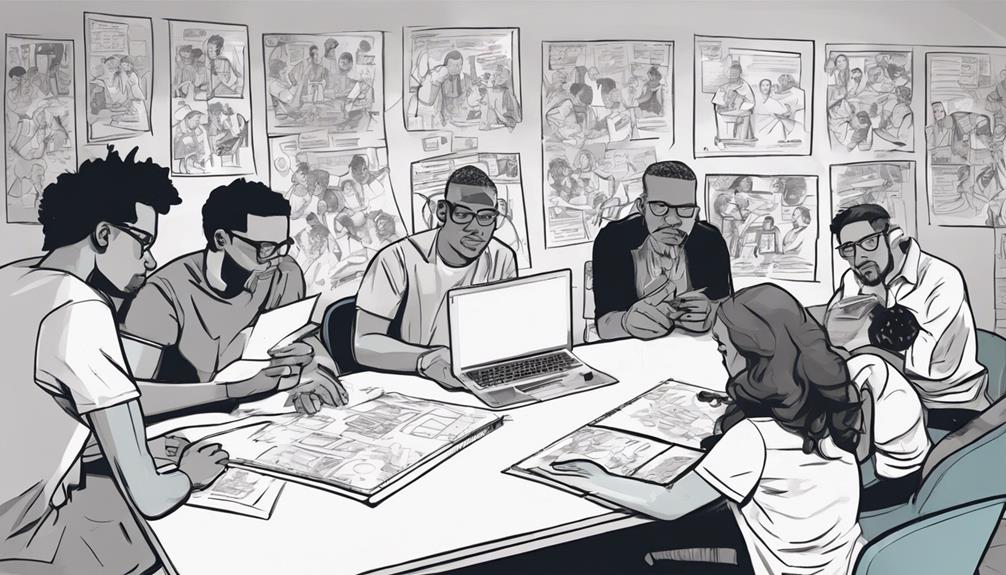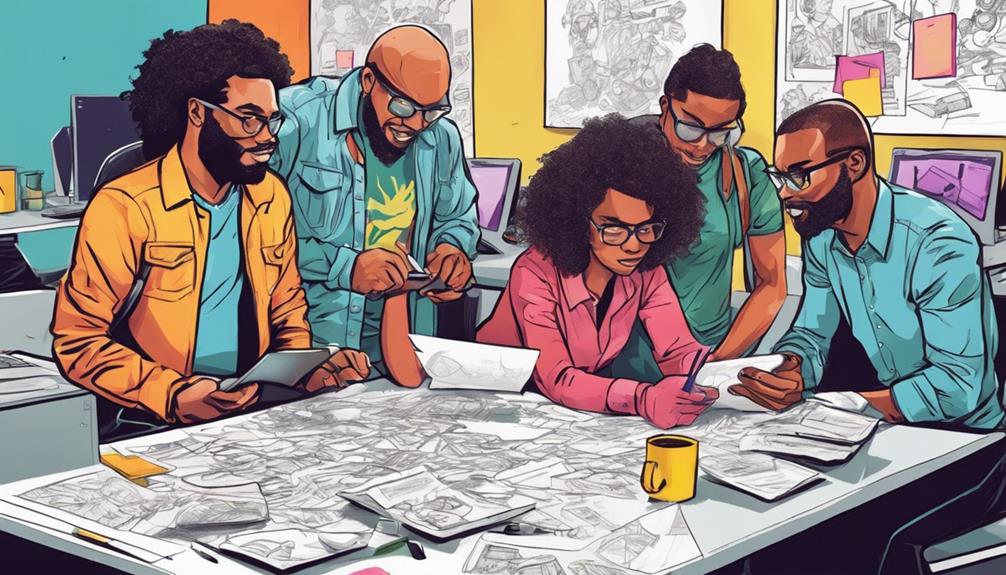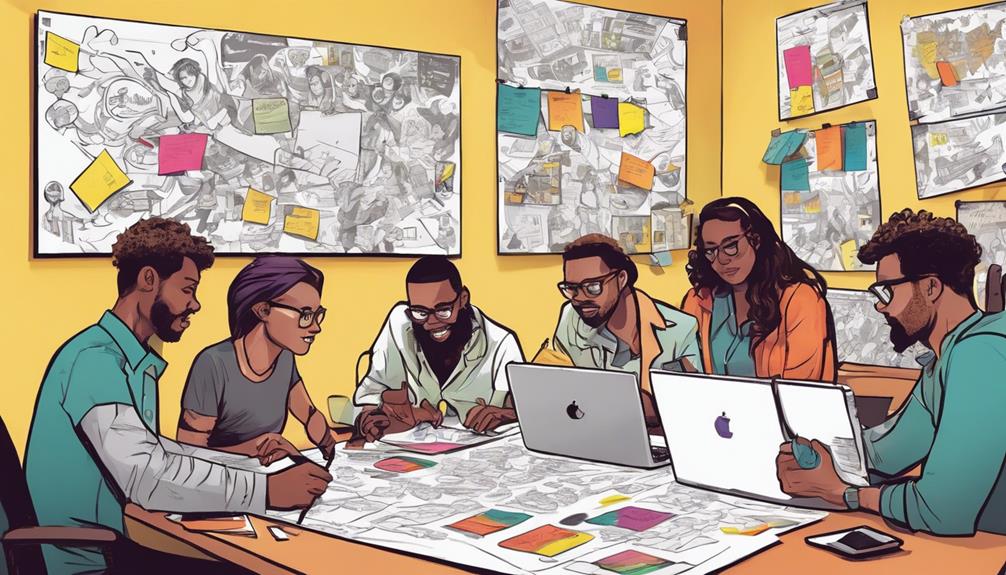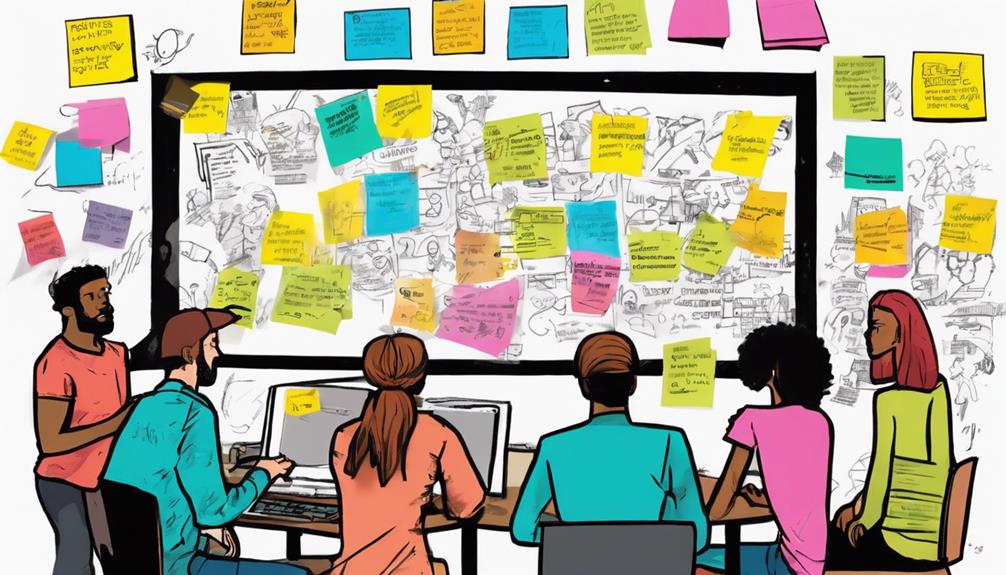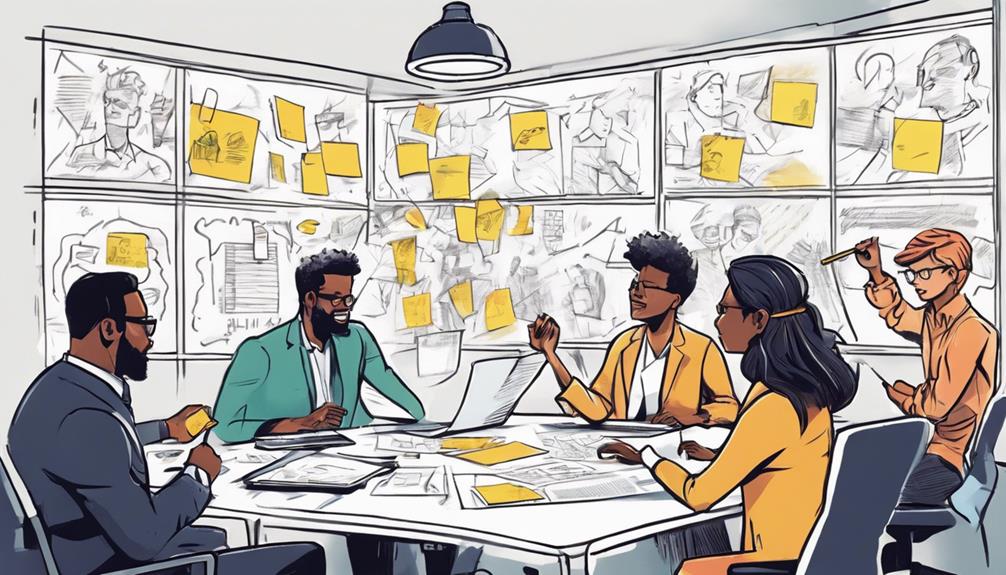Discover the power of Design Thinking, a game-changer in problem-solving and innovation. Explore phases like Empathize and Ideation, ensuring user-focused solutions. Benefit from enhanced collaboration and decision-making, boosting creativity. See Lean and Agile integration for effective outcomes. Embrace a user-centric approach, tailoring solutions to needs. Elevate teamwork and satisfaction through innovative problem-solving. Elevate user experiences and business success with empathy and iteration. Cultivate a culture where empathy and improvement drive results. Immerse yourself in this guide for a deeper understanding of Design Thinking's transformative impact.
Key Takeaways
- Design Thinking involves empathizing, defining, ideating, prototyping, and testing.
- Principles include empathy, user-centricity, tailored solutions, and innovation.
- Integration with Lean and Agile methodologies enhances iterative development.
- Collaboration, innovation, and a user-centric approach drive successful problem-solving.
- Cultivating a culture of empathy and continuous improvement fosters creativity and understanding.
Overview of Design Thinking Process
Explore the five key phases of the Design Thinking process with a focus on problem-solving and innovation. Design Thinking is a user-centric approach that prioritizes understanding user needs and generating creative solutions.
The first phase, Empathize, involves gaining insight into users' experiences and needs.
Following this, the Define phase helps to synthesize findings and define the core problem.
Ideation, the next phase, pushes boundaries by challenging existing assumptions and encouraging innovative thinking to brainstorm potential solutions.
After generating a range of ideas, the process moves into the Prototype phase where rough drafts and mock-ups are created to visualize solutions.
Finally, Testing plays a pivotal role in Design Thinking as it involves gathering user feedback on prototypes to refine and improve the solutions iteratively.
This iterative process fosters innovation by continuously refining ideas based on user input, ensuring that the final product meets users' needs effectively.
Benefits and Principles of Design Thinking

Design Thinking boosts innovation, creativity, and user satisfaction by centering on user-centric problem-solving and fostering a culture of collaboration. Here are three key benefits and principles of Design Thinking:
- Enhanced Innovation:
By focusing on the needs and experiences of users, Design Thinking encourages the development of innovative solutions that address real-world problems effectively.
- Improved User Satisfaction:
Design Thinking principles prioritize creating products and services that resonate with users, leading to higher satisfaction levels and increased loyalty.
- Cultivation of Collaboration:
Emphasizing multidisciplinary teamwork and a user-centric approach, Design Thinking fosters a collaborative environment where diverse perspectives come together to drive creative problem-solving.
Through these principles and benefits, Design Thinking not only enhances decision-making processes and user experiences but also cultivates a culture of innovation and continuous improvement within organizations.
Integration With Lean and Agile

The seamless integration of Design Thinking with Lean and Agile methodologies maximizes efficiency and adaptability in problem-solving approaches. By incorporating Lean methodology, emphasis is placed on streamlining processes, reducing waste, and optimizing resources to achieve effective solutions.
Agile methodology complements Design Thinking by promoting flexibility and quick iterations, allowing for adjustments based on feedback and evolving requirements. When Design Thinking, Lean, and Agile methodologies are combined, they create a powerful synergy that enables iterative development and enhances problem-solving strategies.
This integration fosters a dynamic and efficient problem-solving process that encourages creativity, innovation, and continuous improvement within organizations. The collaborative nature of these methodologies results in a culture that values experimentation, learning from failures, and adapting to changing circumstances swiftly.
User-Centric Problem-Solving Approach
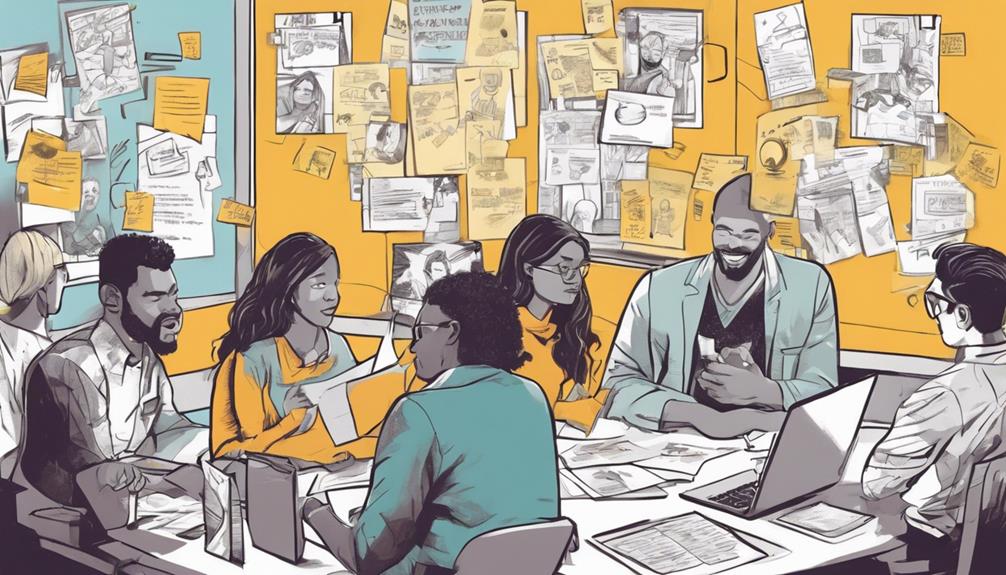
User-centric problem-solving prioritizes understanding users' needs and preferences to drive innovative solutions tailored to their requirements. This approach, embedded in Design Thinking, emphasizes empathy with users to uncover insights and create impactful solutions.
Here are three key aspects to keep in mind in this user-centric problem-solving approach:
- Empathize to Understand: Design Thinking starts with empathizing with users, putting yourself in their shoes to grasp their perspectives, needs, and challenges. This understanding forms the foundation for crafting solutions that truly resonate with users.
- Define User Requirements: After gaining insights through empathy, the next step involves defining user requirements clearly and concisely. This stage ensures that the problem is framed from the user's viewpoint, guiding the subsequent ideation and prototyping processes.
- Create Tailored Solutions: By focusing on users throughout the problem-solving journey, Design Thinking enables the creation of innovative solutions that directly address user needs and preferences. This user-centric approach fosters the development of products and services that resonate with their intended audience.
Collaboration and Innovation Importance
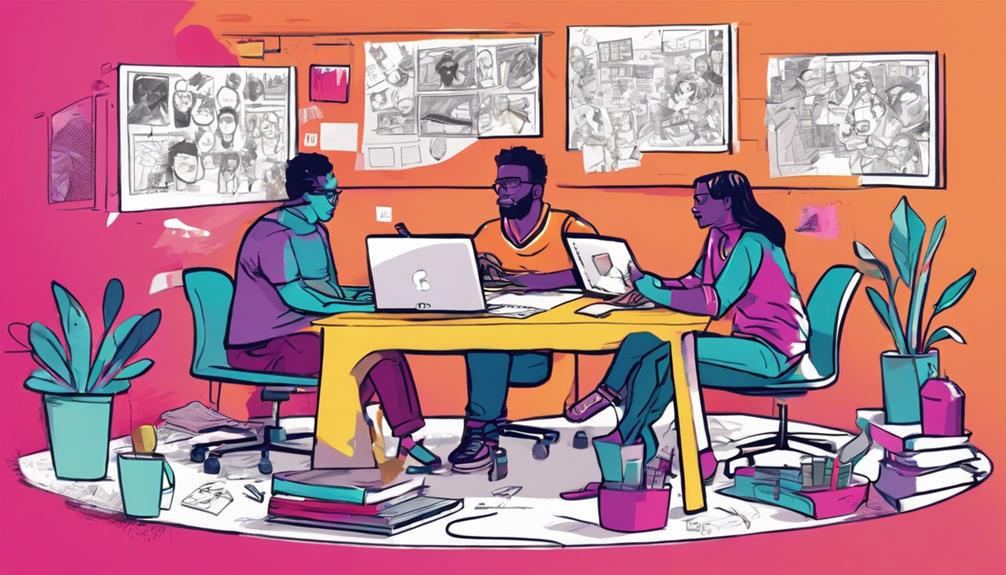
You'll discover that collaboration is key in fostering innovation within Design Thinking.
When diverse perspectives come together, creativity flourishes, leading to unique solutions.
Effective teamwork not only enhances problem-solving skills but also drives user satisfaction.
Innovation in Collaboration
Innovation in collaboration plays an essential role in driving organizational success through fostering diverse perspectives and creative problem-solving approaches. When Design Thinking principles are applied within a collaborative setting, the outcomes can be transformative.
Here's why innovation in collaboration is vital:
- Synergy of Diverse Perspectives: By bringing together individuals with varied backgrounds, skills, and experiences, collaboration enhances creativity and innovation in problem-solving processes.
- Enhanced Communication and Idea-sharing: Encouraging open communication and the sharing of ideas within a team fosters an environment where innovative solutions can flourish.
- Increased Adaptability and Market Competitiveness: Organizations that prioritize collaborative innovation are better equipped to adapt to market changes swiftly, leading to a competitive edge and sustained success.
Creative Team Dynamics
Fostering creative team dynamics through effective collaboration is key to igniting innovation potential in any organization. In the domain of Design Thinking, where problem-solving is at the forefront, the synergy of diverse minds working together is pivotal.
Research underscores that teams emphasizing collaboration aren't only more innovative but also more efficient. When teams prioritize open communication, trust, and psychological safety, they create an environment where innovation thrives. The impact of such dynamics goes beyond mere productivity; it extends to higher job satisfaction and superior problem-solving outcomes.
Studies have consistently shown that teams with robust collaboration and innovation levels are better equipped to deliver successful, user-centered solutions. Companies like IDEO exemplify how prioritizing teamwork and innovation as core values can lead to groundbreaking results.
Embracing creative team dynamics within the framework of Design Thinking isn't just beneficial but indispensable for organizations aiming to stay ahead in a rapidly evolving landscape.
Unlocking Creativity in Organizations
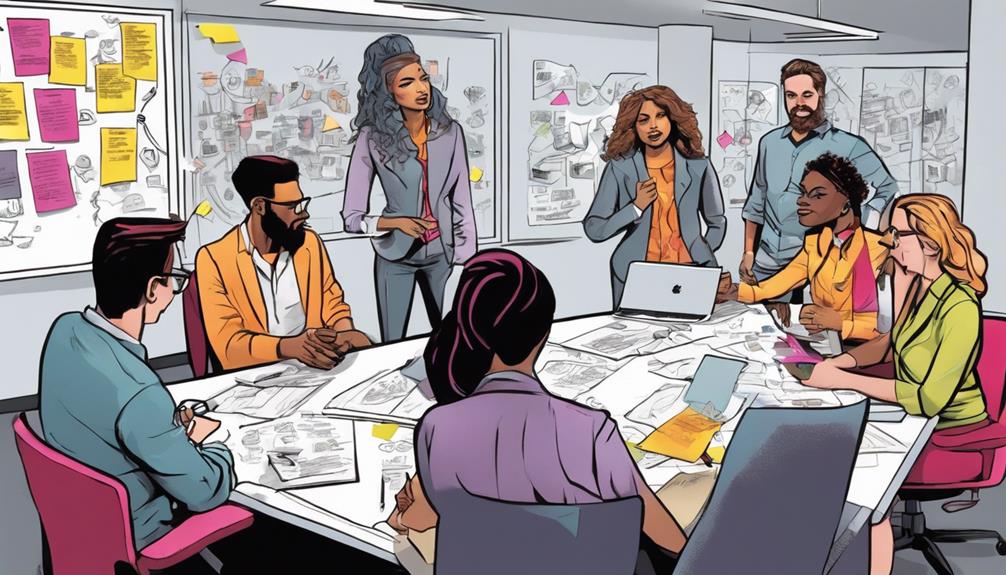
To spark creativity in organizations, implementing Design Thinking methodologies is fundamental to fostering a culture of innovation and collaboration. Design Thinking promotes a human-centered approach to problem-solving, which can lead to groundbreaking solutions.
Here are three essential strategies for securing creativity in organizations:
- Training Teams: By providing teams with training in Design Thinking methodologies, you empower them to think creatively and approach challenges from a new perspective. This training equips employees with the tools needed to address complex problems efficiently.
- Integrating Design Thinking: Embedding Design Thinking into existing processes can transform the way organizations approach innovation. By incorporating this methodology, companies can create a culture that values creativity and collaboration, driving positive outcomes.
- Measuring Success: Establishing metrics to measure the success and return on investment of Design Thinking initiatives is essential for continuous improvement. By tracking the impact of these efforts, organizations can refine their strategies and guarantee long-term success in fostering creativity and innovation.
Improving User Experiences

Understanding user needs is crucial for enhancing user experiences through Design Thinking. Design Thinking places a strong emphasis on empathy, ideation, and prototyping to guarantee that solutions are tailored to the users' requirements.
By incorporating empathy, designers can gain a deeper understanding of user behaviors, preferences, and pain points, which are essential for creating meaningful user experiences. Ideation allows for the generation of diverse ideas, while prototyping helps in visualizing and testing these ideas with users to gather feedback.
Through iterative testing, Design Thinking enables designers to refine their solutions based on user feedback, ultimately leading to enhanced user satisfaction. The principles of Design Thinking promote creativity, collaboration, and innovation in user experience design, fostering a user-centric approach.
Driving Business Success

By implementing Design Thinking in your organization, you can drive business success by fostering innovation and creativity. Here are three key ways Design Thinking can contribute to your organization's success:
- Enhanced Problem-Solving: Training your teams in Design Thinking methodologies can boost problem-solving capabilities by encouraging them to think outside the box and approach challenges from a user-centered perspective. This approach can lead to more effective solutions and innovative outcomes.
- Improved ROI: Measuring the success and return on investment (ROI) of Design Thinking initiatives is essential for understanding the impact on business outcomes. By tracking metrics related to innovation, cost savings, and customer satisfaction, you can demonstrate the tangible benefits of incorporating Design Thinking into your processes.
- Continuous Improvement: Integrating Design Thinking into existing processes can result in ongoing enhancement and better user experiences. By fostering a culture of collaboration, cross-functional teamwork, and innovation, your organization can stay agile and responsive to evolving market demands, driving long-term business success.
Culture of Empathy and Continuous Improvement

Establishing a culture of empathy and continuous improvement within your organization is key to fostering understanding, collaboration, and innovation among team members. By embracing design thinking principles, such as feedback loops and a growth mindset, you can create an environment where learning and adaptation are valued. Encouraging open communication and active listening helps in building empathy among team members, leading to a better understanding of user needs and preferences.
To emphasize the importance of this approach, consider the following table:
| Benefits of a Culture of Empathy and Continuous Improvement | |
|---|---|
| Better understanding of user needs | Enhanced collaboration |
| Solutions evolve to meet changing requirements | Fostered creativity |
Frequently Asked Questions
What Is the Biggest Barrier to Design Thinking?
When diving into Design Thinking, the biggest barrier you face stems from ignoring the need for organizational change. Embrace innovation; shatter resistance. Without this shift, you're stuck in a cycle of missed opportunities.
What Are the 3 P's of Design Thinking?
The 3 P's of Design Thinking are Desirability, Feasibility, and Viability. They help evaluate solutions based on user needs, technical capabilities, and business viability. Focus on what users want, assess technical constraints, and align with organizational goals.
What Are the 5 Points of Design Thinking?
To understand the 5 points of Design Thinking, remember: Empathize, Define, Ideate, Prototype, and Test. These steps guide problem-solving and innovation by focusing on user needs, defining issues, brainstorming solutions, creating prototypes, and testing ideas.
What Are the 3 Most Important Elements of Design Thinking?
To tackle design thinking effectively, remember its core elements: desirability, feasibility, and viability. Prioritize meeting user needs, considering technical constraints, and evaluating business impact. Keep these three in mind for successful solutions.
Conclusion
You've now discovered the power of design thinking. By embracing a user-centric approach and fostering collaboration and innovation, organizations can drive success and improve user experiences.
Remember, design thinking isn't just a process, it's a mindset that values empathy and continuous improvement. So, go forth and apply these principles to access creativity and drive positive change in your organization.
The possibilities are endless when you think like a designer.
